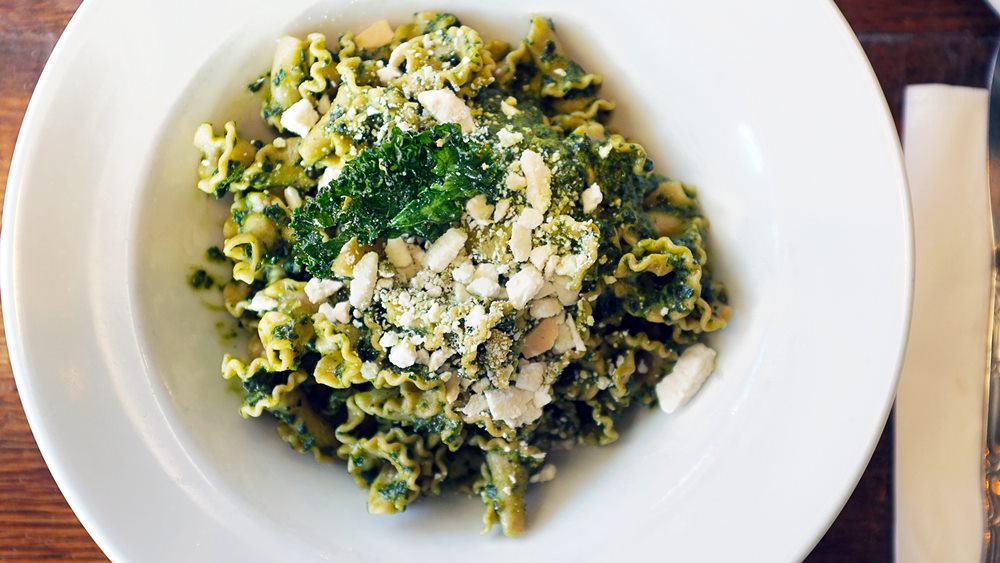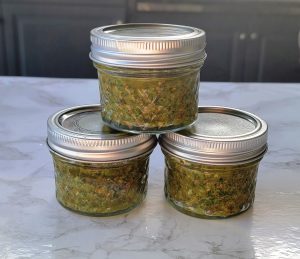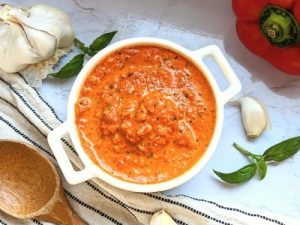Our latest batch of basil needed to be harvested from our lanai, and of course the there had to be pesto made.
With lots of fresh basil showing up every, we thought it would be a good time to discuss this amazingly flavorful sauce. Pesto is not difficult in concept, but you do need just a bit of understanding, and a little bit of experience, to become a pesto experience. With Know Your Pesto, we’ll give you everything you need to know.
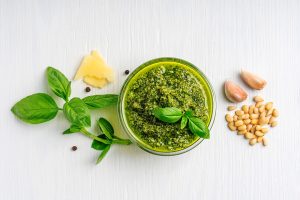 Pesto is actually an ancient a technique which combines nuts, salt, herbs, aromatics (such as garlic), Parmesan cheese and oil blended together to form a paste. Pesto is thought to have originated in Genoa, located in Italy’s northern region, dating as far back as the 16th century. The first written recipe was In 1863 by Giovanni Battista Ratto, from his book, La Cuciniera Genovese. . The word pesto derives from the Italian verb “pestare,” which means to crush. So, traditionally, all pesto were made by crushing and grinding the ingredients in a mortar and pestle. While some of us still use the old technique of mortar and pestle (it does make for a very aromatic, flavorful product), the food processor turns out a pretty good product and it is so much more convenient when you’re making lots of pesto. Just don’t let Nonna know that you used one of those electronic devils.
Pesto is actually an ancient a technique which combines nuts, salt, herbs, aromatics (such as garlic), Parmesan cheese and oil blended together to form a paste. Pesto is thought to have originated in Genoa, located in Italy’s northern region, dating as far back as the 16th century. The first written recipe was In 1863 by Giovanni Battista Ratto, from his book, La Cuciniera Genovese. . The word pesto derives from the Italian verb “pestare,” which means to crush. So, traditionally, all pesto were made by crushing and grinding the ingredients in a mortar and pestle. While some of us still use the old technique of mortar and pestle (it does make for a very aromatic, flavorful product), the food processor turns out a pretty good product and it is so much more convenient when you’re making lots of pesto. Just don’t let Nonna know that you used one of those electronic devils.
Most of the Italian recipes add cheese (almost always Parmesan), and quite a few use vegetables such as roasted peppers, zucchini, and tomatoes. There are versions of pesto, or pesto like sauces, that are found in other cuisines (such as the Spanish Romesco sauce) – but we’ll address those in another article.
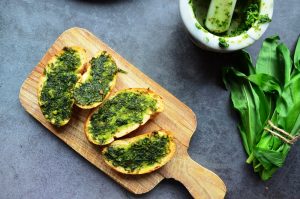
You can freeze pesto for up to a few months – just make sure that you put a piece of plastic wrap on top of the sauce before you seal the container. This does preserve most of the pesto flavor, but the best stuff is freshly make. And that’s why you will never see a Serious Foodie bottled pesto sauce. And why you should never use a store-bought version.
In this article, we explore some of the classic Italian recipes.
Pesto Genovese
Ingredients
- 1/2 cup lightly toasted pine nuts
- 4 cups washed and dried fresh basil (about 3 large bunches)
- 2 garlic cloves, peeled
- 1 teaspoon salt
- 1 teaspoon pepper
- 1/4 lemon
- 1/2 cup olive oil
- 1/4 cup freshly grated Parmesan cheese
Directions
- Combine the pine nuts, basil, garlic, salt, pepper in a food processor or blender. Squeeze in about half of the lemon slice (remove the pits). Pulse until thoroughly chopped.
- With the processor/blender running, slowly pour in the olive oil. Stop the processor/blender. Taste to determine the flavor balance. Add more lemon for brightness, or more salt of pepper to taste. Pulse the processor/blender to mix, and taste again.
- Add the Parmesan cheese, and pulse to combine.
- After packing the pesto in a container, add a thin layer of olive oil, and place plastic wrap directly in contact with the sauce. This will prevent oxidation.
Pesto Trapanese
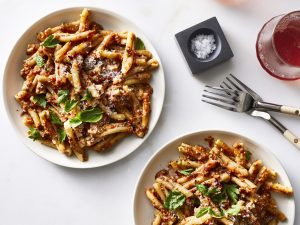
Picture Courtesy of Food and Wine
Ingredients
- 3/4 cup lightly toasted almonds
- 1 cup washed and dried fresh basil
- 2 garlic cloves, peeled
- 1/2 teaspoon salt
- 1/2 teaspoon pepper
- 6 ripe plum tomatoes
- 1/4 lemon
- 1/3 cup olive oil
- 1/4 cup freshly grated Parmesan cheese
Directions
- Combine the nuts, basil, garlic, tomatoes, salt, pepper in a food processor or blender. Squeeze in about half of the lemon slice (remove the pits). Pulse until thoroughly chopped.
- With the processor/blender running, slowly pour in the olive oil. Stop the processor/blender. Taste to determine the flavor balance. Add more lemon for brightness, or more salt of pepper to taste. Pulse the processor/blender to mix, and taste again.
- Add the Parmesan cheese, and pulse to combine.
- After packing the pesto in a container, add a thin layer of olive oil, and place plastic wrap directly in contact with the sauce. This will prevent oxidation.
This recipe will also work with cherry tomatoes; try using some sun dried tomatoes for a variation.
Pesto alle Nocciole (Hazelnuts)
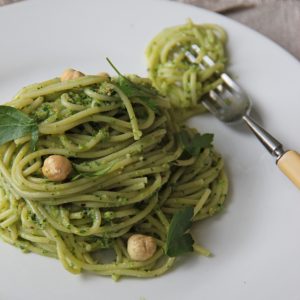
Picture Courtesy of Food and Wine
This is by far our favorite pesto. The hazelnuts lend a sweet earthy flavor that blends perfectly with the garlic, oil, and cheese.
Ingredients
- 3/4 cup lightly toasted hazelnuts
- 2 cups washed and dried basil (you can also substitute with some or all parsley)
- 2 garlic cloves, peeled
- 1/2 teaspoon salt
- 1/2 teaspoon pepper
- 1/4 lemon
- 1/3 cup olive oil
- 1/4 cup freshly grated Parmesan cheese
Directions
- Blanch the parsley in boiling water for 15 seconds, then immediately place in an ice bath. Spin dry.
- Combine the nuts, parsley, garlic, salt, pepper in a food processor or blender. Squeeze in about half of the lemon slice (remove the pits). Pulse until thoroughly chopped.
- With the processor/blender running, slowly pour in the olive oil. Stop the processor/blender. Taste to determine the flavor balance. Add more lemon for brightness, or more salt of pepper to taste. Pulse the processor/blender to mix, and taste again.
- Add the Parmesan cheese, and pulse to combine.
- After packing the pesto in a container, add a thin layer of olive oil, and place plastic wrap directly in contact with the sauce. This will prevent oxidation.
Roasted Red Pepper and Pistachio Pesto
Ingredients
- 1/2 cup lightly toasted pistachios (almonds also work well in this recipe)
- 1 1/2 cups roasted red peppers – patted dry
- 1 cup washed and dried fresh basil
- 2 garlic cloves, peeled
- 1/2 teaspoon salt
- 1/2 teaspoon pepper
- 1/4 lemon
- 1/3 cup olive oil
- 1/4 cup freshly grated Parmesan cheese
Directions
- Combine the nuts, basil, roasted red peppers, garlic, salt, pepper in a food processor or blender. Squeeze in about half of the lemon slice (remove the pits). Pulse until thoroughly chopped.
- With the processor/blender running, slowly pour in the olive oil. Stop the processor/blender. Taste to determine the flavor balance. Add more lemon for brightness, or more salt of pepper to taste. Pulse the processor/blender to mix, and taste again.
- Add the Parmesan cheese, and pulse to combine.
- After packing the pesto in a container, add a thin layer of olive oil, and place plastic wrap directly in contact with the sauce. This will prevent oxidation.
Try your own variations by using different herbs (parsley, tarragon, thyme, sage), switching nuts (pumpkin seeds, walnuts, cashews, etc.), adding other roasted vegetables (mushrooms, zucchini) – the combinations are only limited by your willingness to experiment.
Tell us about your favorite pesto recipe! Connect with us on Facebook or Instagram or the contact form below.

